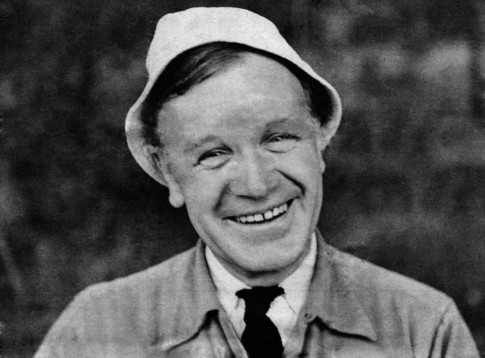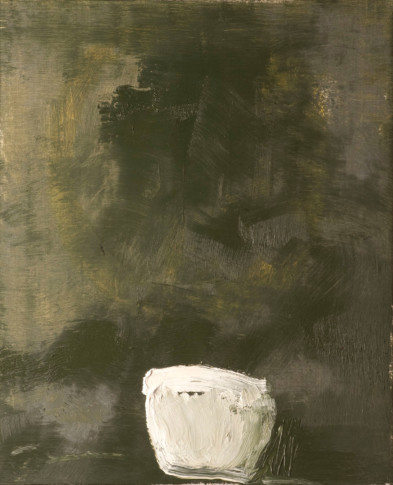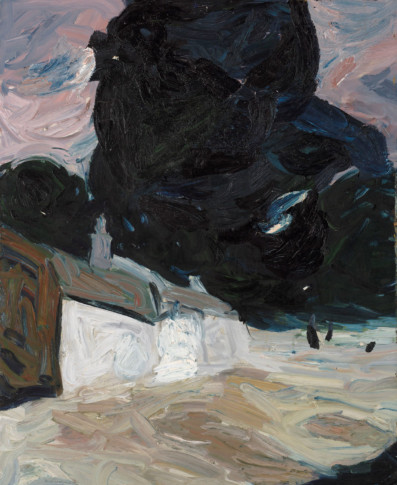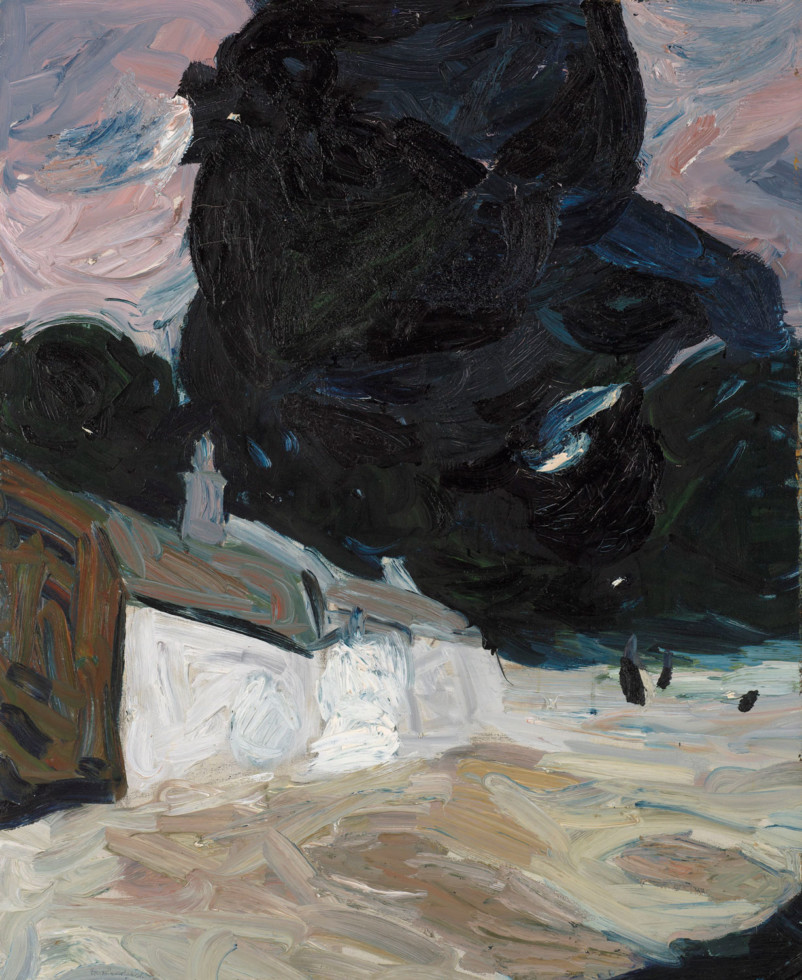
Evert Lundquist, De vita husen i viken I, 1938 © Evert Lundquist
Artists on Lundquist
Torsten Andersson
Three quarters of what is written in Sweden about Lundquist is about “the comfy-cosy” image, about the slippers and pipe-smoking; the remaining quarter gets hushed up.
The remaining quarter is about an artist breaking away from the norms and conventions of his middle-class life. In Evert Lundquist’s case, this escape would occur at the restaurant table and, fortunately, in the studio as well.
At the restaurant table, Lundquist’s personality would “appear to be transformed”, his pipe-smoking became manic and was not the slightest bit cosy. When his pipe was out of his mouth, his lips would move as though he was still smoking. After midnight he would become disillusioned and sarcastic; a new personality as an individual person took shape. That was the person I liked.
Something similar happened in the studio. A new visual language seemed suddenly to come into being. The material on the canvases broke away from its 1930s bonds and went its own way, coming alive and proliferating. The paintings became heavier and heavier, in terms of both their weight and their contents. A new personality took shape in the form of a language. It was a language I liked.
I saw Lundquist’s paintings hanging alongside those of Asger Jorn at the Guggenheim Museum in New York in 1966. There Lundquist found himself in an exclusive set-up: cohabiting with the world’s best painter but each with their own home. Lundquist exhibited a language that was liberated and independent and the personality of an individual with a charisma all his own.
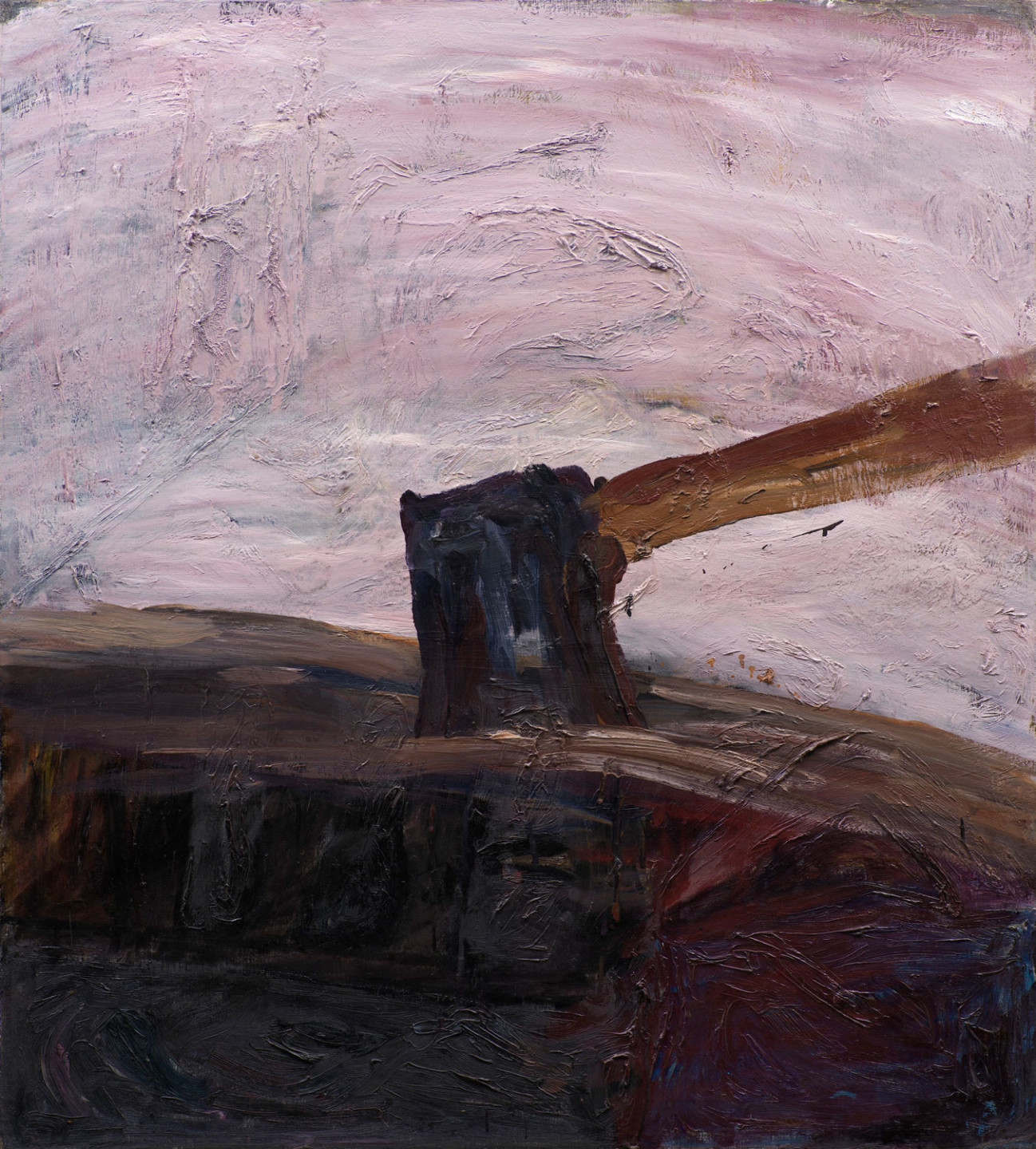
Georg Baselitz
Why would somebody paint an ax in a chopping block in 1963 and hang it in an exhibition at the Lützowplaz in Berlin? Most certainly so that I would happen to stop by, see the 100 x 80 cm picture, and turn over and over in my mind right down to today, forty-six years later, the question as to whether I ought to start over again from the very beginning. But perhaps I ought instead to travel there, to the North, because C.F. Hill hung alongside only four meters away, check whether Curzio Malaparte’s equestrian army has reemerged from the ice, and use the chance to visit that Swedish master of the forge, Gränfors Bruks.
Andreas Eriksson
When I gained admission to Konsthögskolan (the Royal University College of Fine Arts) in 1993, I was interviewed by the local paper in my home town which wanted me to name a favourite artist of mine. That was Evert Lundquist. At that time I was very taken with a classical form of painting made up of still lifes, landscapes and portraits in earthy colour schemes. A year or two into my training I had become increasingly involved in formal experiments in painting; strangely, Lundquist’s paintings were still just as present to me. My interest had simply shifted to those paintings of his that were executed as though they were remnants and in which the overpainting is more explicit. In them the physical distance between the swiftly sketched image and its very simple motif stands in enormous contrast to the almost endless layers of underlying paintings that are concealed between the canvas and the picture.
When I left Konsthögskolan and began to focus more on my personal narrative, an interest in Lundquist’s “existential” period during the late 1930s and early 1940s became increasingly pronounced. A more painful form of painting with its credibility still intact would be hard to find. During this period, when he was painting a la prima and mixing the pigments directly on the canvas, there is an entirely different relationship with his subject matter and the application of pigment on display. As I experience these works, the pigment moves from side to side, establishing a contrast with the later works with their profoundly inward movement of layer upon layer upon layer.
Surprisingly, it is Lundquist’s way of handling pigment that frequently makes him a rather divided painter. I think it is this that also makes him one of my artistic companions and favourites. Two paintings may actually share the same motif and colours but be totally unalike in terms of the application of the paint and so appear to be two essentially different works. This proves to me how little the various subjects really mattered. It was nevertheless all the more important that the painting should depict something and be furnished with the substantial frame that he often forced on his paintings, as a means perhaps to more easily “excuse himself” for the unruliness with which the material was treated. I have been working for my part in a uniform format and have only very recent begun to include photographs in order to entice myself into a form of painting that is as free as possible.
Per Kirkeby
There isn’t much on the anecdotal plane to tell. I only ever met Evert Lundquist once. Olle Granath took the gallerist Michael Werner and myself on a studio visit. A gallerist and an artist. There was something about Lundquist’s motif, objects which seemed to correspond to something in time, a New Spirit in Painting, to quote a contemporary exhibition title – a claim for the return of painting after the desert of images in the art world.
There was something fundamentally false about this story. Painting had, of course, never been gone. There was Lundquist, and Leroy, and other underground workers. Michael Werner, with the best eye of his time, had seen right through the whole “postulated painting” scene and had turned his attention to Leroy, where he also found Lundquist. He tried to buy a few etchings by Lundquist. But Evert was on his own turf in his studio, a studio that had grown around its artist. He wouldn’t sell anything. He emanated a relaxed assuredness in himself and his art that made him immune to the temptations of the art world. He was beyond those shallow ambitions and he had found life with, and in, his paintings. Like Munch in his twilight years in Ekely. Completely indifferent to the demands and desires of the world around him. These old men painted what they had to paint.
When an artist writes about another artist it can easily become self-promotional in a way that both disguises the other artist and vampirically exploits him for his own benefit. On the other hand, the artist does have the experience to write with. A sense of achievement that neither the critic nor the art historian has access to. I experienced it as an unexpressed contract, and as respect. It mostly flattered me, of course, but Evert was also there in that subterranean world. I experienced the same with Eugène Leroy. Perhaps the sense of some brotherhood amongst those that paint the slow pictures.
Sigrid Sandström
I have been promised an invitation to Vaxholm to have a look at a painting by Evert Lundquist. Before I leave I study a reproduction of the work. A woman has been placed in its centre. She appears to be standing at the very front of the painting with an open landscape behind her. On the horizon to the right a clump of trees can be made out; this might be a thickly wooded island. The island reminds me of the Toteninsel by Arnold Böcklin. But the distinctive brushwork and the transparent moistness it conveys make the association in my mind to a contemporary artist – to Peter Doig’s painting 100 Years Later, in which a man with long blond hair in a canoe is observing the viewer while an exotic island can be glimpsed in the background. In Lundquist’s painting, too, the light seems exotic, hot in an un-Swedish way. An ivory-coloured field extends between the woman and the horizon – it calls to mind Ivan Aguéli’s bright Mediterranean landscapes. I discover a faint grey shadow on the right next to the woman’s shift. Such a short shadow, such a short distance… and now I realise that what I interpreted as a spreading field is actually a wall, and that the distance I believed to stretch over hundreds of yards is only a matter of inches, and that my field of vision is, in fact, blocked. It is only now that I notice what might be a gatepost on the right. Perhaps the island is really the top of a hidden tree. The painting is entitled Kvinna vid den vita muren (Woman by the White Wall) with woman in the indefinite form and the wall in the definite. Does that mean the wall is actually more familiar than the woman? I try to find the woman’s eyes and realise that what I had interpreted as a face is in fact the back of a neck.
Going back on the Vaxholm boat I reflect on what I have just seen. It offered no confirmation that it really was the back of the neck. Quite the contrary. Nothing looked the way I had imagined it; it was all bewilderingly unlike the reproduction, and I was struck by the way the febrile brushwork seemed to have a life of its own quite independently of the subject matter. Like a wet, shivering fur coat – lacking in rhythm but of a piece – it covers the surface, demanding attention. Those areas that appeared to be transparent turn out to be very thickly painted. The pigment billows across the painting, as though it had been applied over an underlay of sweeping hills. The pigment is scrumptiously present, a chewing-gum surface that is misleading. What remains is a mirage with the woman floating across the ground. She fades in and out of the picture as though she were in two minds about her very existence. Her shift, on the other hand, would appear to have been stuck fast to the painting, as intrusively tangible as if it had been made out of gauze bandage and glued on. And an inward, yellowish light seems to emerge from the lower section, quite independent of the external daylight, a visual and mystical lightness at the heart of the impasto pigment. What were grey shadows in the reproduction turn out to be a striking blue, bits of fabric rather than shadows. The woman is wearing a hat. That had escaped my notice before. From a distance the throat/neck part disappears and the head seems to be floating free. There is no gaze to meet. When I ask the owner of the painting if she thinks it portrays a face or a neck, she replies immediately that what it looks like to her is a face seen slightly aslant and from the side: yet another possibility.
As I now recall the painting, I think above all of the way the vibrating, febrile energy that makes up its surface evokes pulsating depths. The moment you define the wall as a wall, it gives way and becomes an atmosphere. Or rather the reverse: the atmosphere becomes a wall. The field of vision in Lundquist’s painting is not only blocked by the wall, but also by the brushwork which undercuts and undermines simplistic interpretations. What we are faced with is a visual quagmire in which the subject matter (or the narrative) seems to have been assigned a subordinate significance; it is the way the pigment has been applied that takes over. And, as such, my initial association to both Böcklin’s island and Doig’s man in the canoe seems all the stranger. In contrast with the crucial significance assumed by the choice of subject matter in their works, the motif in Lundquist’s painting is a diversion almost, or an invocation of its real – and as yet unexpressed – message.

